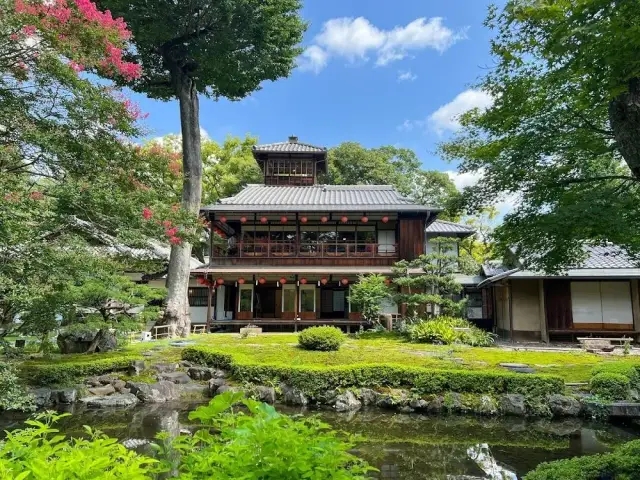https://www.dekitabi.com/itinerary/nijo-castle-kyoto-imperial-palace-tour
Kyoto, Japan’s ancient capital, is a city steeped in history and culture. For travelers seeking to immerse themselves in Japan’s rich heritage, Kyoto offers an array of historical sites that vividly capture its past. Among these, Nijo Castle, Kyoto Imperial Palace, Former Mitsui Family Shimogamo Villa, and Heian Jingu Shrine stand out as must-visit landmarks. Each of these sites presents a unique glimpse into Kyoto’s storied history and architectural splendor.
Nijo Castle: A Symbol of Shogunal Power

https://www.dekitabi.com/attraction/nijoo-castle
Nijo Castle, a UNESCO World Heritage Site, stands as a testament to the power and influence of the Tokugawa shogunate. Built in 1603 by Tokugawa Ieyasu, the founder of the Tokugawa shogunate, this castle was not only a symbol of shogunal authority but also a magnificent example of Japanese castle architecture. The castle is renowned for its intricate “nightingale floors,” which squeak when walked upon to alert of intruders, and its lavish interiors adorned with exquisite artwork and craftsmanship.
Visitors to Nijo Castle can explore the beautifully preserved Ninomaru Palace, where shoguns held court and entertained guests. The palace’s ornately decorated rooms and gardens provide insight into the opulence and grandeur of the era. The castle grounds also feature beautiful gardens, including a stunning cherry blossom grove that blooms in spring, enhancing the castle’s scenic beauty.
Kyoto Imperial Palace: The Heart of the Japanese Monarchy

https://www.dekitabi.com/attraction/kyoto-imperial-palace
The Kyoto Imperial Palace, once the residence of Japan’s imperial family until the capital moved to Tokyo in 1869, is a central landmark in Kyoto. Nestled within the Kyoto Gyoen National Garden, the palace complex consists of elegant structures set amidst expansive gardens. The palace’s architectural style reflects traditional Japanese aesthetics with its graceful pavilions and meticulously designed gardens.
The Kyoto Imperial Palace offers visitors a chance to explore the intricacies of imperial life. Although the inner areas of the palace are not open to the public, guided tours provide insights into the history and significance of the palace. The surrounding Kyoto Gyoen National Garden, with its beautiful landscapes and seasonal floral displays, adds to the allure of the visit.
Former Mitsui Family Shimogamo Villa: A Glimpse into Aristocratic Life

https://www.dekitabi.com/attraction/old-mitsui-family-shimogamo-villa
The Former Mitsui Family Shimogamo Villa, located near the historic Shimogamo Shrine, is a charming example of traditional Japanese aristocratic architecture. This villa, once the retreat of the Mitsui family—one of Japan’s wealthiest merchant families—showcases the refined taste and elegance of the Meiji era.
The villa features beautifully landscaped gardens, serene ponds, and traditional wooden architecture. Visitors can enjoy a leisurely stroll through the gardens, which offer a tranquil escape from the bustle of the city. The villa’s interior, with its tatami mat rooms and sliding doors, provides a glimpse into the lifestyle of Japan’s elite during the late 19th and early 20th centuries.
Heian Jingu Shrine: A Fusion of Tradition and Modernity

https://www.dekitabi.com/attraction/heian-jingu-shrine
Heian Jingu Shrine, established in 1895 to commemorate Kyoto’s 1100th anniversary, is a relatively modern shrine that beautifully merges traditional and contemporary elements. The shrine’s architecture is inspired by the Heian period (794-1185), reflecting the grandeur of the era when Kyoto was the capital of Japan.
The shrine’s expansive grounds include a striking vermilion gate, spacious courtyards, and a stunning garden known for its seasonal beauty. The garden, divided into the South Garden and the East Garden, features ponds, bridges, and meticulously arranged flora. In spring, the garden’s cherry blossoms create a picturesque setting, while autumn brings a vibrant display of red and orange foliage.
Conclusion: A Journey Through Kyoto’s Historical Legacy
Kyoto’s historical sites—Nijo Castle, Kyoto Imperial Palace, Former Mitsui Family Shimogamo Villa, and Heian Jingu Shrine—offer a rich tapestry of Japan’s cultural heritage. Each site presents a unique aspect of Kyoto’s past, from the shogunal power of Nijo Castle to the imperial grace of Kyoto Imperial Palace, the aristocratic elegance of the Former Mitsui Family Shimogamo Villa, and the modern yet traditional beauty of Heian Jingu Shrine.
For those planning a visit, these landmarks provide a profound understanding of Japan’s history and architecture. Exploring these sites allows travelers to connect with the legacy of Kyoto and appreciate the city’s enduring cultural significance. Whether you’re captivated by historic castles, imperial palaces, or serene gardens, Kyoto’s historical treasures offer an unforgettable journey through Japan’s illustrious past.


Leave a Reply